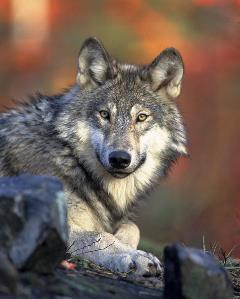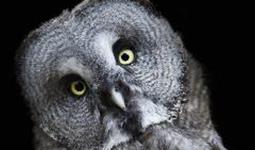Some animals see in the dark!
Imagine being able to see in the dark. You might see owls swooping through the night sky or mice running in the dark grass. The environment is very different at night.
Owls can see at night. So can cats and foxes. Animals active at night are called nocturnal. These animals have a special ability that allows them to see in the dark: night vision!
 Animals use night vision to help them find food or avoid predators. Some nocturnal animals also have a strong sense of smell or hearing. The eyes of nocturnal animals differ from human eyes. You are able to see during the day because there is a lot of light from the sun. Your eyes use this light to help create an image in your brain. Nocturnal animals can do the same thing using very small amounts of light.
Animals use night vision to help them find food or avoid predators. Some nocturnal animals also have a strong sense of smell or hearing. The eyes of nocturnal animals differ from human eyes. You are able to see during the day because there is a lot of light from the sun. Your eyes use this light to help create an image in your brain. Nocturnal animals can do the same thing using very small amounts of light.
The eye is made up of many different parts. When a nocturnal animal sees light, the pupil allows light to enter the eye. The pupil is the black part of the eye. The pupil sends the light onto the retina. The retina is made up of cells called rods and cones. Rods look like tall cylinders and cones look like small triangles
Nocturnal animals have more rods than daytime animals. The rods pick up light and help the animal see when it is almost completely dark outside.
Many animals eyes have a special part called a tapetum lucidum. The tapetum lucidum helps with night vision. It is made of thick reflective cells and is beneath the retina.
 The tapetum lucidum is sort of like a mirror. It reflects light back to the retina a second time. This gives the rods a second chance to absorb the light. Sometimes light reflects off the tapetum lucidum, and the animals eyes appear to glow. You might have seen this happen with a pet dog or cat. Animal scientists can actually look for glowing eyes to find animals at night.
The tapetum lucidum is sort of like a mirror. It reflects light back to the retina a second time. This gives the rods a second chance to absorb the light. Sometimes light reflects off the tapetum lucidum, and the animals eyes appear to glow. You might have seen this happen with a pet dog or cat. Animal scientists can actually look for glowing eyes to find animals at night.
Human eyes do not have a tapetum lucidum. The glowing "red eye" in photographs is actually caused by a reflection off the retina of the eye. If we did have a tapetum lucidum, we might have night vision too!
You can see nocturnal animals at your local zoo. Nocturnal animals are often kept in dark houses with special lighting that lets you see them during the day.
Try It - Study your own eye anatomy!
 Anatomy is the study of parts of the body. You can study anatomy by looking at your own eye in a mirror. You could also try this activity in the classroom by having a friend look at your pupil. You will see how the black pupil of the eye is surrounded by a colored part called the iris. The iris gets bigger and smaller depending on how much light needs to get into the pupil.
Anatomy is the study of parts of the body. You can study anatomy by looking at your own eye in a mirror. You could also try this activity in the classroom by having a friend look at your pupil. You will see how the black pupil of the eye is surrounded by a colored part called the iris. The iris gets bigger and smaller depending on how much light needs to get into the pupil.
What to do:
Stand in front of a mirror in a well-lit room. Look at your own pupil. How big is it?
Close your eyes. Count slowly to 30 before opening them.
Does your pupil look different? Did it get bigger? Did it get smaller?
Nocturnal animals: The aye-aye
One interesting nocturnal animal is the aye-aye. Aye-ayes are a small kind of lemur. Aye-ayes live in trees on the island of

Madagascar. They have dark brown or black fur and big, bushy tails. They also have big eyes to help them see in the dark!
Aye-ayes have a unique way of finding food. They have one very long finger on each hand. They use the long finger to tap on tree branches and pieces of wood. The tapping helps them hear insect larvae moving inside the wood. Once they find a hidden insect larva, they scoop it out and eat it!
Aye-ayes are omnivorous. This means they eat meat (from insects) and they eat plant material. They use that long finger to scoop food out of coconuts and other fruits.
Some people think aye-ayes are spooky. This belief has led to overhunting. The aye-ayes are also threatened by habitat destruction. Today there are laws to protect aye-ayes.
If you are ever in Madagascar, listen for a tapping noise at night. That could be an aye-aye looking for breakfast!


